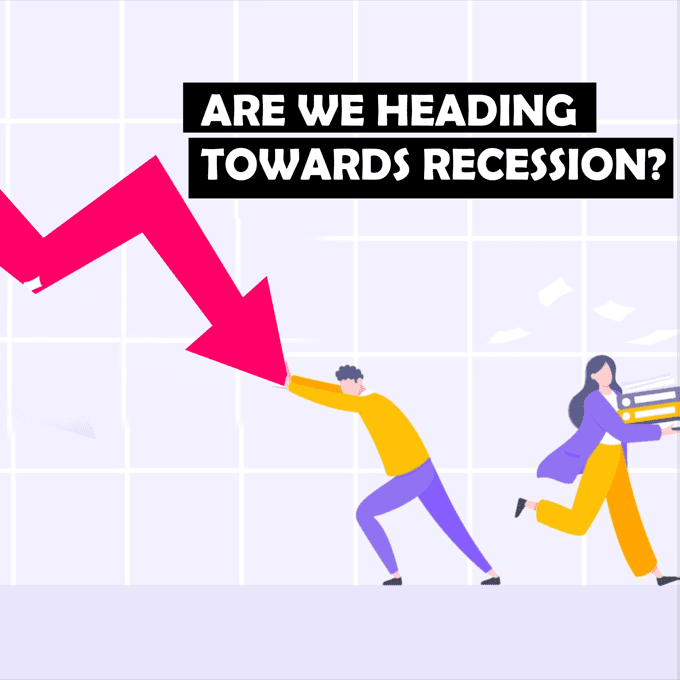Off late you must’ve heard talks of recession and how it could affect our country. It’s not just you, the entire world is talking about it, including leading economists, global news channels, big investors and major investment banking companies. Before we talk about impact of Recession on India, let’s first understand what it is.
What is a Recession?
By definition, a Recession is when a country’s economic growth slows down or shows a negative trend for two continuous quarters (GDP). In simpler terms, people have less money to spend, which leads to reduced business activity and eventually more people lose their jobs.
COVID lockdowns have affected every single country on the planet. It’s been two years now and we are still fighting to get back to normal. Adding to this, we now have the Russia-Ukraine conflict, which has impacted the entire supply chain of the global economy, further increasing the inflation in every country.
Major factors which lead to Recession
- High Inflation
- Excessive Debt
- A sudden disturbance in the economy like covid, financial crisis – 2008 etc.
A recession doesn’t happen due to a single factor, and also it doesn’t happen overnight. Various factors influence a recession. For example, COVID and the war have affected every single economy. Countries like Srilanka, Argentina, Japan, and Italy are under excessive debt.
We live in the era of globalization and the world is one big family. If one country goes down due to recession, then there is a domino effect affecting several other nations. Financial experts from Deloitte, Morgan Stanley, Citigroup, JPMorgan Chase, Credit Suisse, S&P Global Ratings, Goldman Sachs and Deutsche Bank have predicted that the US will go into recession in the upcoming quarters.
As we speak, the US is the largest economy. If the US goes into recession, then it will have cascading effects on almost all the countries. We have seen this in the past. For example 1933 – Great Depression and the 2008 – financial crisis.
As unemployment rates are one of the key indicators for an economy to be under recession. The figures are showing positive in the US, but the two-quarter GDP result says that the US is technically under recession.
Impact of Recession on India
Source – Economic Times
India’s GDP growth forecast is above 7.4% for FY 2022-2023. This is enormous when compared to other major economies like the US, China etc. The average inflation rate in India for the past 10 years is from 5% to 6% which is slightly increased to 6.71% (as per June 2022 data). At the same time, average inflation for countries like the US, and Europe is between 2% to 4%, which has now drastically increased from 7% to 9%.
As Federal communities started increasing their interest rates in March 2022, and it is believed that the rate hikes are expected until the end of next year to ease the inflation in the US, which will make every other country increase the interest rate including India. As per LiveMint Federation of Indian Chambers of Commerce & Industry (FICCI) says Inflation in India is predicted at 6.7% for FY 22-23, and it is expected to come down to 4% in June 2023 considering the upcoming repo rate hikes in India.
The major impact of the recession will be on India’s exports if countries like the US, and China go under recession as India stands in a better place in terms of food security, forex reserves etc, According to Trading Economics china takes care of 16% of total imports in India, whereas the US takes care of 6% and United Arab Emirates (6 percent), Saudi Arabia (5 percent) and Switzerland (5 percent).
At the same time, this will get offset by lower commodity prices like crude oil. India’s major import is crude oil & gold which occupies 85%. If a recession affects the major countries the crude oil price will ease. For example – in the 2008 financial crisis, the price of one barrel of crude oil was US$147 and due to the recession, it came down to around US$36 per barrel.
USD/INR and Unemployment
Recent factors have led INR to trade at an all-time low against the USD, affecting our imports. RBI is taking necessary steps like increasing interest rates, controlling inflation and swapping US currency for INR to increase the demand for INR in the global market.
Although the pandemic has impacted global economies, India has a different story to tell, especially on unemployment. As per Economic Times, India’s unemployment rate was at 6.1% in 2017-18, 5.8% in 2018-19, 4.8% in 2019-20 and further reduced to 4.2% in 2020-21.
In all honesty, the data shows that even though we are in the middle of a global crisis, India is in a better position when compared to developed and developing economies.
